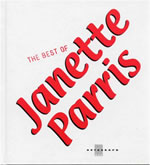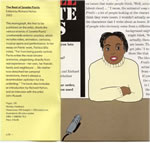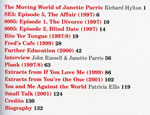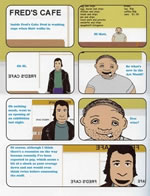The Best of Janette Parris
This monograph, the first to be published on Janette Parris, charts the various strands of the artist’s unashamedly eclectic practice, which includes video, animation, cartoons, musical opera and performance. In her essay on Parris’ work Patricia Ellis notes, “Far from being purely cynical, Parris, writes the most sincere scenarios, plagiarising directly from real experience – her own, her friends’, family and neighbours’…No matter how detached her personal revelations, there’s always a downtrodden optimism for the underdog.” The Best of Janette Parris includes many of the artist’s major works produced between 1997 and 2001 including the Plank and Bite Yer Tongue cartoons, scripts and documentation of the musicals You’re the One and If You Love Me, and excerpts from animations such as Fred’s and Further Education.
More +
This book brings together Janette Parris' unashamedly eclectic work, which includes video, animation, cartoons, performance and theatre, produced between 1997 and 2001. As a storyteller Parris is disposed to narratives which speak about the mundaneity of urban life, troubled relationships, frustrations and the ever-present fear of failure. That’s not to say it’s all doom and gloom. For whilst Parris’ observations are sometimes bleak, they also come tempered with poignancy and hilarity. It is perhaps surprising then that in Parris’ narratives very little happens, usually the bare minimum. However, conversely, a lot is said about the human condition.
I first encountered Parris’ work in 1996 in a show called The Happy Shopper. In the exhibition, she presented a short video piece on a domestic television and video player. The five-minute work in which an actor performed alongside a small handmade doll was called SE5: Episode 2, Betrayal. The basic plot revolved around a boyfriend who comes home to discover his girlfriend, played by a doll, sharing a bed with another man, played by an actor. Distraught, the boyfriend throws the girlfriend out of the flat. It was a strange piece. Possessing all the qualities of low-budget video production, it also utilised dialogue familiar to soap opera. Parris’s narrative was presented as emphatically deadpan. The fact that one of the characters was a doll made it all the more ridiculous. Devoid of climax or spectacle, the scene somehow appeared to be quite extraordinary. The feeling of the anti-spectacle was further compounded in subsequent soap opera works where the dynamic between actors and mute dolls remained non-existent. Examples of this include the cries from the clandestine lover in SE5: Episode 5, The Affair (1997), the wife’s regretful monologue in 8005: Episode 1, The Divorce (1997) and the man’s pregnant pauses in 8005: Episode 2, Blind Date (1997). While soap opera narratives rely on suspense and dramatic effect, Parris’ narratives are deliberately lack these qualities. Despite the low-key nature of these episodes, SE5 and 8005assumed a quasi-public information role, warning of the pitfalls of relationships…
Excerpt from 'The Moving World of Janette Parris' by Richard Hylton.



